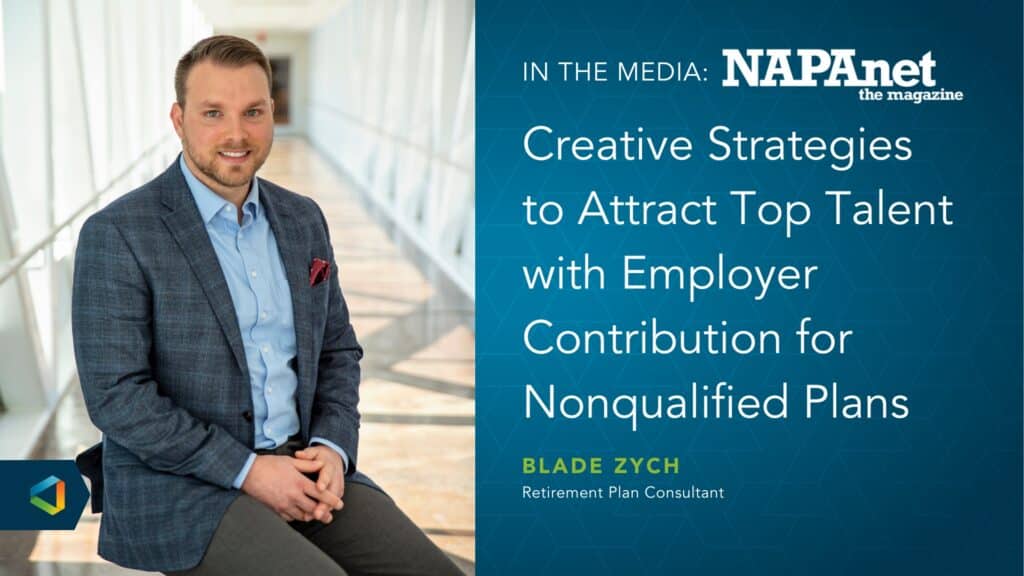Better Benefits, Lower Costs
Maximizing the Effectiveness of NQDC Plans for Better Retirement Readiness
Maximizing the Effectiveness of NQDC Plans for Better Retirement Readiness
Nonqualified deferred compensation plans (NQDC) can provide an effective strategy that enables employers, as plan sponsors, to compensate key employees on a deferred basis. But why would companies be concerned about deferring compensation for a limited number of executives when the inflationary economy has many employees feeling challenged to save at all?
Offering deferred compensation plans to key executives can position small to midsize companies to compete with larger organizations for talented, proven leaders within their industries. With a range of funding options for NQDC plans available, companies have latitude regarding when and how they fund the plan. This added leeway may translate to a balance sheet or cash flow feature of significance for companies of all sizes.
From the plan participant’s perspective, compensation paid through a well-designed NQDC plan is not limited in the same way federal laws restrict the amount of pre-tax earnings an employee can save through a qualified program, such as a 401(k) plan. NQDC plan participants can make up or recoup benefits they otherwise lose due to restrictions that cap the amount of pre-tax earnings any worker can save through a qualified plan.
When talented leaders are inspired by deferred compensation plan vesting schedules to stay for the long haul, companies become more stable. Plan participants can feel confident their personal financial security is a concern to their employer and is being strategically addressed. And the critical key leadership that an organization relies on is free from personal financial distractions to focus on company growth.
From company competitiveness to potential financial benefits for the plan sponsor and the plan participant, NQDC plans may be an attractive part of an executive’s retirement readiness strategy. However, some of the plan’s most important benefits may be left on the table unless there is purposeful education about the plan’s options and potential.
Employee Benefits Education for Understanding the Timing and Form of Plan Payouts
NQDC plans are not subject to most of the Employee Retirement Income Security Act regulations known as ERISA. Instead, these flexible, customizable plans are regulated by Internal Revenue Code (IRC) Section 409A, which was established as part of the American Job Creation Act of 2004.
Section 409A requires plan participants to select the “timing and form” of their retirement payout. When NQDC plan participants understand their timing and form of payout options, they can make informed decisions that better serve their personal savings goals and objectives.
Unfortunately, executive benefits education is sometimes overlooked. Employers may assume that their high-achieving executives don’t need retirement readiness education. Timing can also add to the challenge, as traditional enrollment periods often overlap end-of-year responsibilities already on the executive’s plate. Plan participants may not understand the personal value of strategically selecting the timing and form of their plan payout unless their employer commits to retirement plan education for every team member, from the front line to the C-suite.
Lump It and Leave It … or Choose to be Strategic
Electing lump sum distribution of the NQDC plan payout may appear to be a quick and easy decision for a plan participant, especially when retirement feels like an event still years away. But electing lump sum payouts can be the least effective way to participate in the plan.
When plan participants decide on or default to a lump sum distribution from their NQDC plan, they can unintentionally push themselves into the highest marginal tax bracket at the payout time. The solution to avoiding tax-burden overload is to strategize timing and form of payout with multiple bucket or class year plans.
Multiple Bucket Plans or Class Year Plans
If an NQDC plan is designed with only one retirement distribution election, it is described as a single bucket structure. All payouts within a single bucket structure are distributed on the same schedule. However, most plan administrators can support an NQDC plan that offers plan participants the features and flexibility of various distribution options.
A multiple bucket approach allows the participant to select a unique payout schedule for every bucket. When provided the option of the multiple bucket approach, with each bucket having specific terms, plan participants can receive their payout in a lump sum, in multiple annual installments or a combination of the two.
A class year approach to receiving NQDC plan payouts is another strategy that enables the participant to select discrete schedules for distribution. One year’s payout can be scheduled for distribution as a lump sum, while in a different year, the plan participant may choose to receive the payout in multiple installments.
While some hard deadlines exist regarding deferral and re-deferral, plan participants not only have the flexibility to customize the timing and form of their NQDC distribution, but they also have the option to adjust their choices as the years go by.
The Power of an Effective Retirement Plan Paired with Participant Education
Nuancing payout schedules and arrangements, year by year, may at first thought feel unnecessary or like retirement plan overkill. But an executive’s retirement landscape may be complex, built on high earnings with perhaps multiple employers and various saving strategies, most of which will be subject to required minimum distribution timing and income taxes.
Designing plan flexibilities that will be appreciated by the NQDC plan participant and then teaching the plan participant how to achieve the full value of these options can maximize the effectiveness of the NQDC plan. When this happens, both the executives and the entire organization benefit.
Want to read more about nonqualified deferred compensation plans? Check out our recent articles: IRS Audits and the Nonqualified Deferred Compensation Plan and Hitting the Home Run in Deferred Compensation.
This material has been prepared for informational purposes only, and is not intended to provide, and should not be relied on for, accounting, legal or tax advice. You should seek specific advice from your tax professional before pursuing any idea contemplated herein.
Investment advice is offered through OneDigital Investment Advisors LLC, an SEC-registered investment adviser and wholly owned subsidiary of OneDigital.




